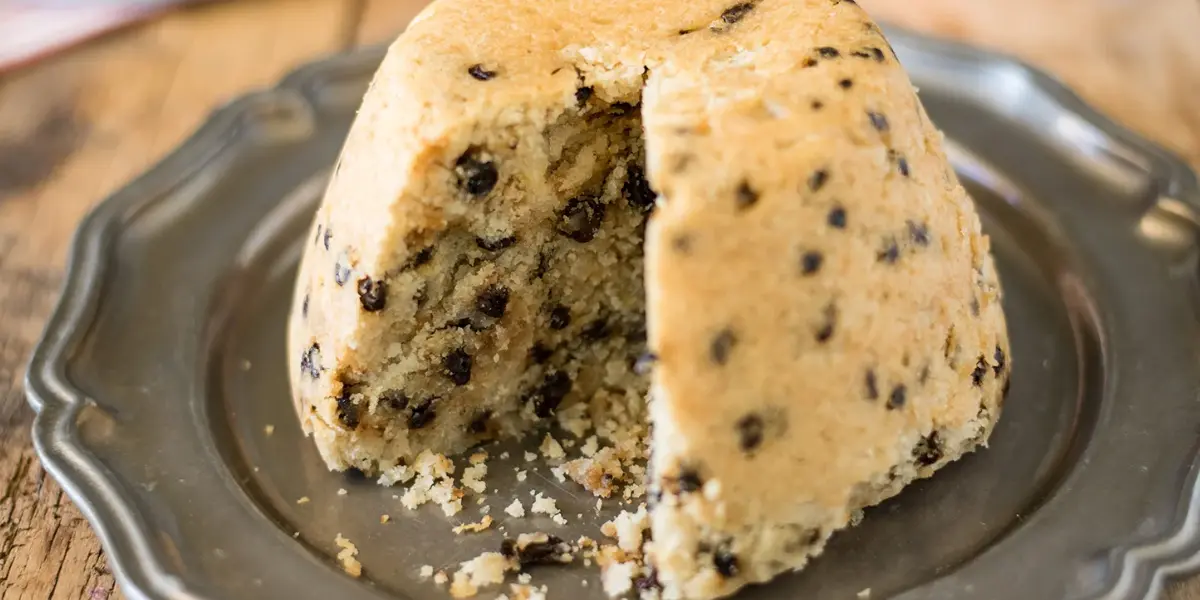If you’re looking to try a traditional British dessert, there’s nothing quite like a Spotted Dick recipe. This classic steamed suet pudding is filled with dried fruits and has a light, fluffy texture that makes it a favorite across the UK. Despite its humorous name, this dessert has a long history and is loved for its rich, comforting flavor.
Whether you’re preparing it for a festive dinner, a cozy weekend treat, or just experimenting with British cuisine, this recipe is simple to follow and yields delicious results every time.
Ingredients You’ll Need
Before you start, gather the following ingredients for your Spotted Dick recipe:
- 225g (8 oz) self-raising flour
- 100g (4 oz) suet (vegetable or beef)
- 75g (3 oz) caster sugar
- 150g (5 oz) currants or raisins
- 1 tsp baking powder
- 1 tsp mixed spice (optional, for extra flavor)
- 150ml (5 fl oz) milk
- Pinch of salt
- Butter for greasing
Pro Tip: If you want a healthier twist, consider using half wholemeal flour and a sugar substitute like erythritol.
Step-by-Step Instructions
1. Prepare Your Pudding Basin
Grease a 1-litre pudding basin with butter. This ensures the pudding won’t stick and makes serving easier.
2. Mix the Dry Ingredients
In a large bowl, combine flour, suet, sugar, baking powder, salt, and mixed spice. Stir in the currants or raisins so that they’re evenly distributed throughout the mixture.
3. Add the Milk
Gradually add milk to the dry ingredients, mixing gently to form a soft, sticky dough. Be careful not to overmix, as this can make the pudding dense.
4. Fill the Basin
Spoon the mixture into the prepared pudding basin and level the top. Cover with a layer of greaseproof paper and then aluminum foil, securing tightly with string.
5. Steam the Pudding
Place the pudding basin in a large pot with enough water to come halfway up the sides. Cover with a lid and steam for about 2 hours, topping up the water as needed.
6. Serve and Enjoy
Once cooked, carefully remove the pudding from the basin and serve warm. Traditionally, Spotted Dick is accompanied by custard, which adds a creamy sweetness to every bite.
Tips for the Perfect Spotted Dick
- Use Fresh Suet: Fresh suet gives the pudding a lighter, fluffier texture compared to pre-packaged versions.
- Steaming Matters: Make sure the water in your pot doesn’t boil dry; top it up to ensure even cooking.
- Serving Ideas: Serve with custard, cream, or even a drizzle of golden syrup for a decadent dessert.
For those looking for more dessert inspiration, you could also check out our post on foodfables.co.uk to balance indulgence with everyday treats.
The History Behind Spotted Dick
Many people are curious about the origins of this amusingly named pudding. The term “spotted” refers to the dried fruits that create dark spots in the dough, while “dick” is an old English term for pudding. This dessert has been enjoyed since the Victorian era and remains a staple in traditional British cuisine today.
Interestingly, Spotted Dick has also made appearances in modern British pop culture, showcasing its enduring appeal. For more historical insight into traditional British puddings, you can explore resources like The British Library’s food history archive.
Variations to Try
- Chocolate Spotted Dick: Add 50g of dark chocolate chips to the mixture for a chocolatey twist.
- Gluten-Free Version: Substitute self-raising flour with a gluten-free blend to make this pudding suitable for all dietary needs.
- Citrus Infusion: Add a teaspoon of orange zest to give the pudding a refreshing citrus note.
FAQs About Spotted Dick
1. What is the difference between Spotted Dick and Christmas pudding?
Spotted Dick is a simpler suet pudding with dried fruits, while Christmas pudding is richer, often includes alcohol, and is traditionally served during the holiday season.
2. Can I make Spotted Dick in advance?
Yes! This pudding can be made a day in advance and reheated by steaming it again for 20–30 minutes.
3. Is suet necessary in Spotted Dick?
Suet is traditional and gives the pudding its characteristic texture, but vegetable suet or vegan alternatives can be used for dietary preferences.

